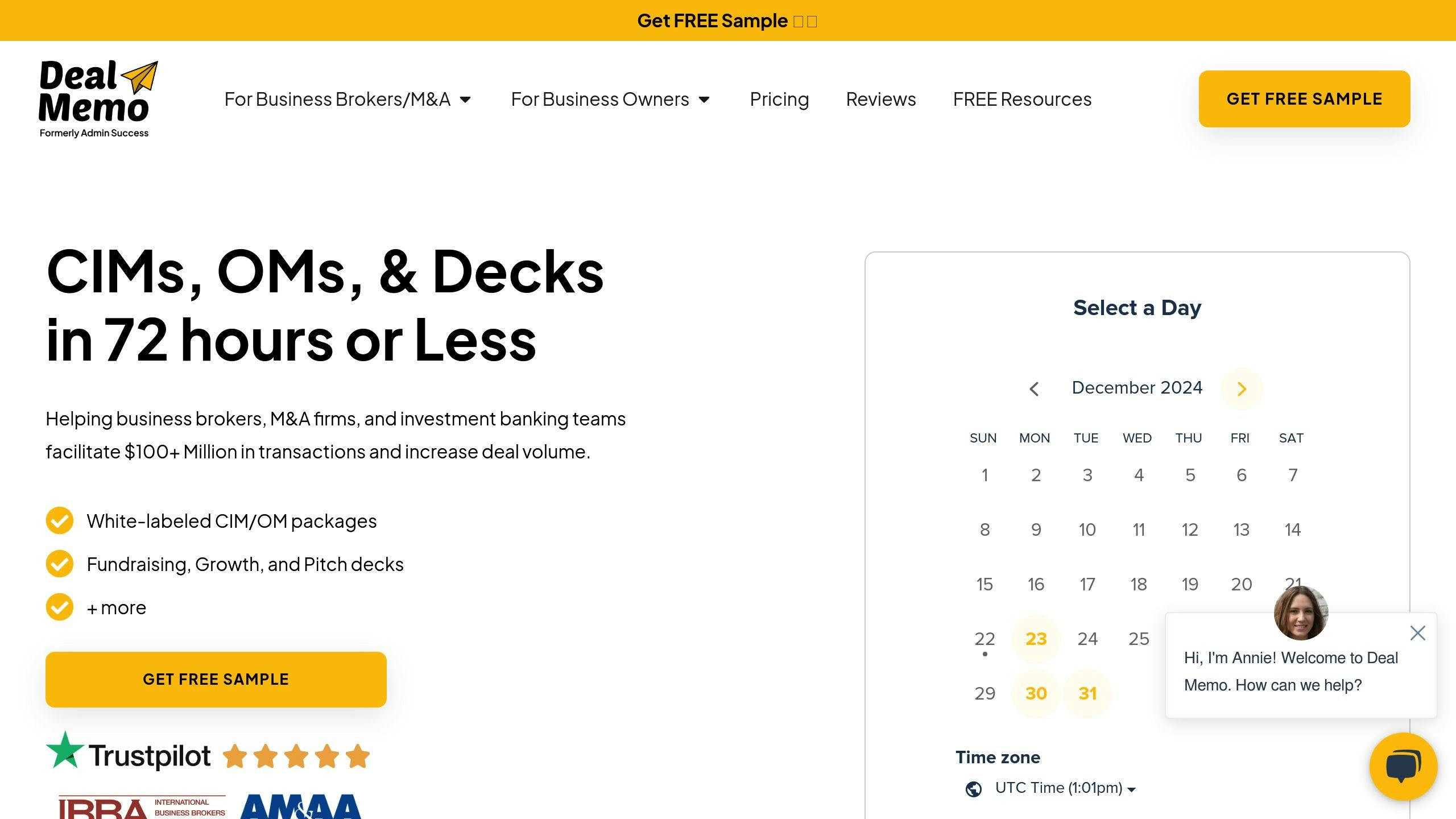Creating a Confidential Information Memorandum (CIM) is crucial in sell-side M&A transactions. It’s the document that introduces a company to potential buyers, blending persuasive storytelling with accurate data. A strong CIM can speed up deals, highlight value, and build buyer confidence.
Key Takeaways:
- Purpose: A CIM helps buyers assess fit, lays the groundwork for due diligence, and showcases growth potential.
- Main Sections: Includes an executive summary, market analysis, financial data, and projections.
- Process: Collaboration between the client, investment bankers, and internal teams ensures accuracy and strategic presentation.
- Tips: Use clear formatting, visuals, and concise writing to balance detail and brevity.
This guide breaks down how to craft effective CIMs, from structuring content to streamlining the process with tools like Deal Memo.
Key Sections of a CIM
Executive Summary and Company Introduction
The Executive Summary is your chance to make a strong first impression on potential buyers. This section should emphasize the most attractive aspects of your business, such as:
- The core business model and what sets it apart
- Key financial metrics and the company’s growth story
- Competitive strengths and current market position
- Highlights of investment opportunities and future growth prospects
The Company Introduction takes this a step further by offering a deeper dive into the company’s history and current standing. This section should clearly outline the company’s journey, operational structure, and strategic goals. Together, these elements provide the foundation for the market context discussed later.
Market Analysis and Competition
A thorough market analysis gives potential buyers a clear understanding of the larger landscape. Key elements to include are:
- Market Size: Define the total addressable market (TAM) and serviceable addressable market (SAM).
- Growth Drivers: Highlight industry trends, emerging technologies, and any regulatory shifts that could impact the business.
- Competitive Landscape: Identify key competitors, market share distribution, and barriers to entry.
- Positioning: Explain the company’s strengths, market share, and potential for growth.
To back up your analysis, use trusted sources like Gartner, IDC, Forrester, or Bloomberg. This not only strengthens your argument but also allows buyers to independently assess the market opportunity. Once the market context is established, the financial data section provides the numbers buyers need to evaluate the opportunity.
Financial Data, Projections, and Metrics
The financial section often gets the closest scrutiny, so it’s important to present this information clearly and effectively. Break it into two main parts:
Historical Performance
- Provide 3-5 years of detailed financial statements.
- Highlight key performance indicators (KPIs).
- Analyze revenue streams and cost structures.
Forward-Looking Projections
- Outline growth assumptions and the factors driving them.
- Detail any capital and working capital requirements.
Visual aids like charts and graphs can help illustrate trends and make the data easier to understand. Be sure to explain what drives each financial metric and how it compares to industry benchmarks. While projections in a CIM are not binding, they offer valuable insights into the company’s potential.
For a polished and professional presentation, consider using services like Deal Memo to ensure your financials are consistent and aligned with the rest of the document.
Guidelines for Writing and Formatting CIMs
Structuring Content for Clarity
A well-organized CIM guides readers seamlessly from the company overview to its growth opportunities. Use clear, descriptive headings to establish a hierarchy, making it easier for readers to find specific details while maintaining a logical flow.
Here are some tips to keep your document clear and organized:
- Start each section with a brief paragraph to set the stage.
- Use consistent formatting across similar types of information.
- Break down complex topics into smaller, focused subsections.
- Ensure smooth transitions between major sections to maintain flow.
This structured approach sets the stage for effectively incorporating visuals, which we’ll cover next.
Effective Use of Visuals and Data
Visual elements like charts, graphs, and tables can make dense information more engaging and easier to understand. Use them to emphasize key trends or relationships that support your narrative.
Keep these tips in mind when adding visuals:
- Choose the right format for the data (e.g., line graphs for trends, bar charts for comparisons).
- Use a clear color hierarchy and consistent labeling for readability.
- Always cite reliable, industry-standard sources.
Balancing Detail and Brevity
To keep readers engaged while providing enough detail:
- Focus on information that directly impacts investment decisions.
- Move technical details or lengthy data to appendices.
- Write concisely without sacrificing important details.
- Use white space strategically to break up dense text.
- Highlight key metrics and accomplishments in callout boxes.
"A CIM is not a binding contract but omitting or not disclosing any key fact may lead to investors losing confidence in the entire process and the deal might get abandoned midway."
Every element in your CIM should support your company’s story and strengthen your investment thesis. If something doesn’t serve this purpose, leave it out – even if it’s interesting on its own.
sbb-itb-798d089
Crafting an Effective Confidential Information Memorandum: A Guide
Improving the CIM Creation Process
Once you’ve nailed down the basics of content creation, the next step is to focus on making the process more efficient. Producing high-quality CIMs requires a thoughtful mix of the right tools, smooth teamwork, and a strong emphasis on consistent branding.
Using Services Like Deal Memo

Tools like Deal Memo can save time without sacrificing quality. As mentioned in the Financial Data section, Deal Memo offers white-labeled CIMs in just 72 hours. They handle everything from seller interviews and data room setup to providing unlimited revisions, helping you meet tight deadlines with ease.
Improving Team Collaboration
Collaboration is key to getting things done efficiently, especially when multiple stakeholders are involved. To streamline teamwork, investment banking teams should focus on:
- Using version-controlled document management systems
- Adopting cloud-based tools for real-time editing
- Scheduling regular progress check-ins
- Establishing clear approval workflows
These steps help avoid miscommunication and keep everyone on the same page throughout the process.
Maintaining Brand Consistency
A consistent brand image is crucial for projecting professionalism and earning trust from potential buyers. To achieve this, investment banking teams should use standardized templates and style guides that reflect their firm’s identity.
When working with external services, share your branding guidelines upfront. This includes details like preferred fonts, color schemes, and formatting rules to ensure all deliverables align with your firm’s look and feel. Consistency here leaves a lasting impression.
Conclusion and Actionable Insights
Key Points About CIMs
Creating a Confidential Information Memorandum (CIM) requires a thoughtful mix of detailed content and polished presentation. A strong CIM should clearly showcase your client’s strengths by using data to link past performance with future expectations.
Some standout elements include:
- Professional design that aligns with your client’s branding
- Clear financial narratives that tie historical results to future goals
- Market positioning backed by credible third-party research
Steps for Investment Bankers
To improve your CIM process, here are some practical tips:
- Use Templates for Efficiency: Leverage standardized templates or tools to save time, especially for tight deadlines.
- Focus on Visual Data: Highlight key trends and opportunities with easy-to-understand charts and visuals, avoiding overwhelming raw data.
- Streamline Collaboration: Implement version control and regular check-ins to keep everyone on the same page during the creation process.

